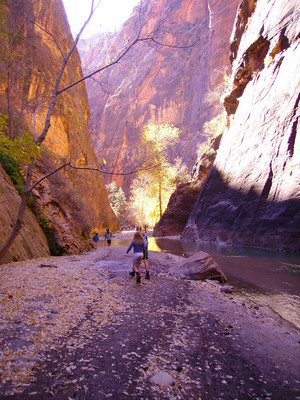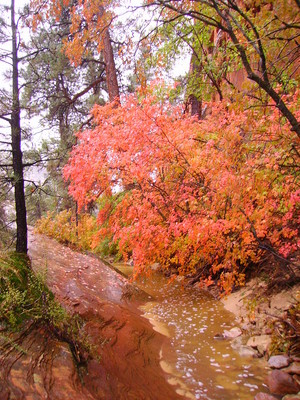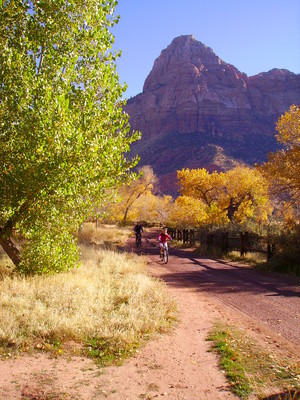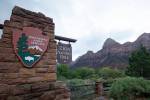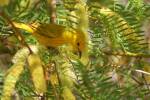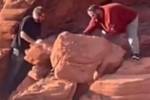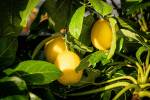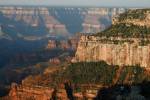Fall Wonderland
It would be hard to find a more striking scene on earth than an autumn day in Zion National Park. Although the park at any season is a visual feast, surrounding the viewer with red, orange and tan sandstone monoliths, fall offers an additional color palette provided by deciduous trees.
Zion's upper elevation areas such as in Kolob Terrace and Kolob Canyons are already experiencing peak or even past-peak color, but in Zion Canyon proper, it usually takes place over the next week or so.
The park's main attraction is the six-mile Zion Canyon Scenic Drive, and for good reason. It is not only where you can find some of the finest scenery but where mature cottonwoods and other deciduous trees flank the North Fork of the Virgin River as it serpentines its way downstream through the canyon.
Even before the cottonwood trees turn their signature golden yellow, the fiery bigtooth maples capture every eye. Michael Plyler, director of the Zion Canyon Field Institute, said there are two great places to find the red trees on that drive.
"Between the Grotto area and Weeping Rock, there are thick pockets of bigtooth, and also near the Big Bend area," he said.
For those wanting to hike, some of the best trails in the park are accessed from the scenic drive. Angel's Landing is a hike of legendary beauty, but it's only for surefooted and fit adults who aren't scared of heights. It is a steep 21/2-mile hike one-way, and along the last half mile you will need to hold onto heavy chains to help you safely walk along a narrow ridge with perilous drop-offs on either side. Once you reach the summit you will have panoramic views of Zion Canyon, 1,200 feet below.
If you aren't up to such an undertaking, there are plenty of easy and short hikes as well, some even suitable for strollers and wheelchairs. The paved 1-mile Riverside Walk at the northern end of the scenic drive is an excellent choice for all ages and abilities.
This trail starts at the Temple of Sinawava and travels up the east bank of the Virgin River. Throughout the walk you will be within a riparian habitat, but along the way there are also two interesting microhabitats -- hanging gardens and desert swamps.
Hanging gardens form on the sandstone cliffs where water seeps out of the walls. This happens because water collects in the porous Navajo sandstone above and soaks down until it hits the denser Kayenta formation below, where it is forced out of the walls in springs and seeps. Growing along this "spring line" you will find maidenhair ferns, golden columbine and shooting stars. Desert swamps occur where water from springs creates pools. Constant shade in the deep canyon maintains a wet and damp environment, which seems very cozy to amphibians such as the leopard frog and tiger salamander, and plants such as horsetails, cattails and scouring rush.
All along the trail you will find cottonwoods, velvet ash, and box elder, all good for fall color displays. "The Riverside Walk also has quite a profusion of bigtooth maple in the first one-quarter to one-half of a mile," Plyler noted. This segment of the trail is also the best place to see deer, rock squirrels and wild turkeys.
The walk ends at what is known as the Gateway to the Narrows. This is the starting point for day hikes up to the world-famous Zion Narrows and the point where adventurers emerge after the 16-mile downstream combination of hike, swim, and scramble.
A day hike is the easiest and most popular way to visit the Narrows. For this, you just hike as far as you feel comfortable and then return the way you came. Because of the flash flood potential in the canyon, though, even such a short hike requires forethought and preparation.
Although the ideal months to hike the Narrows are May, June, September and October, it is still an option now. The average water temperatures in November are 45-50 degrees, so even a few minutes in the chilly water can become a miserable and potentially dangerous experience, but if you are outfitted properly all is well. For through hikes or extended day trips this time of year, you will need properly layered clothing and a drysuit, which can be rented in nearby Springdale. But for a short day trip during low water days, you might get away with warm clothing, neoprene socks and special shoes designed for water hiking, which you also can rent. People in ordinary shoes will freeze; those who try it in ordinary sandals will not only freeze, but also bleed and perhaps break ankles.
I have hiked the Narrows a dozen times, both through hikes and day trips, and found each trip unique depending on water level, weather, and with whom I was traveling. On my last visit, two of my daughters joined me on a short hike up the Narrows. Although traveling upstream from the bottom doesn't require a permit, we stopped at the backcountry desk at the visitor center. Here we received a clear-weather forecast and a low-water flow report for the river. Because it was late fall with water temperature less than 50 degrees, we donned those neoprene booties under our rented river shoes.
We left the landlubbers behind us and headed upstream. In just 100 yards or so, the canyon walls already became quite close, and the river became our trail. We each chose our own route upstream, trying to find the shallowest water and each using a tall wooden walking stick for balance as we made dozens of river crossings over extremely slippery rocks.
Because of the cold, we only traveled a couple of miles upstream, to the river's confluence with Orderville Canyon, before we called it quits. Had our feet been warmer, we would have continued just a little farther, to a highlight called Wall Street, where sandstone cliffs rise close to 2,000 feet but stand only 20 to 25 feet apart.
Although the Virgin River on most days seems a gently flowing waterway, it has been the means by which this magnificent canyon was formed, relentlessly carving the sandstone for millions of years -- a work of nature's art that continues today.
While on the scenic drive, it is well worth a stop at the Zion Lodge, the only accommodations within the park. The main lodge has a gift shop and an excellent restaurant with canyon views. There is also a large common room to sit in and relax or view the fine collection of photographs that line the walls. Outside is a wide expanse of grassy lawn complete with one of the largest Fremont cottonwood trees you may ever see. I am told it is more than 90 years old. This area is often frequented by wild turkeys, and at dusk you can practically be guaranteed to see a few deer.
Once you have exhausted all your choices in Zion Canyon, another good place to go is the park's east side. The trip is worth taking for the drive alone, up about 1,100 feet over a series of steep switchbacks and then through the Zion Mount Carmel Tunnel. A little over a mile long, dark, and narrow, the tunnel took three years to build and was completed in 1930.
Another place to look for fall color is along the Pa'rus Trail. A 31/2-mile round-trip, it is easy, paved, wheelchair accessible and the only trail in the park on which bicycles are permitted. The tree-lined trail runs directly along the Virgin River as it travels from South Campground to Canyon Junction and has plenty of places to access the river.
For those who want to expand their knowledge about Zion, or just want another excuse to visit this agreeable place, the Zion Canyon Field Institute offers workshops and service projects year-round on a wide range of subjects.
On Nov. 3-4 there is a one- or two-day seminar on Zion geology. Ken Puchlik, an exploration geologist with 35 years of field experience in the Southwest, is the instructor. Day one concentrates on Zion's geological past and day two on the continuing cutting and shaping of the canyon. Participants will take a look at slot canyons and the Zion Narrows and see evidence of past rock falls and landslides in the constantly changing landscape.
Nov. 8 is the popular "Thursday trek" which starts with an indoor presentation. Then it is out in the field for an interpretive hike with a naturalist who will touch on a wide variety of topics.
Most November days in Zion are clear with only a minimal chance of thunderstorms. On average, temperatures will be in the 60s during the day and 30s at night.
Good sleeping weather in a warm bag, good hiking weather in a fleece jacket, but fleeting autumn waits for nobody. Seize the day!
Contact Deborah Wall at Deborabus@aol.com.
GETTING THERE
Location: Zion National Park, about 144 miles northeast of Las Vegas in Southern Utah, next to Springdale.
Directions: From Las Vegas, take Interstate 15 north 125 miles to Utah Route 9 (Exit 16-Hurricane/Zion National Park). Follow Route 9 east for 19 miles to the main entrance of Zion National Park.
Season: Year-round.
Lodging: Zion Lodge, the only accommodation in the park, has 40 historic Western-style cabins and 75 motel rooms, dining room; www.zionlodge.com. Zion Park Inn, 1215 Zion Park Blvd., Springdale, (435) 772-3200, www.zion parkinn.com.
Zion National Park: Entrance fee $25 per auto, $12 per pedestrian, bicycle or motorcycle, good for seven days. Zion Canyon Scenic Drive is only open to private vehicle traffic November through March. It is accessible only by shuttle bus from April to the end of October, except for guests of the Zion Lodge. (435) 772-3256, www.nps.gov/zion.
Zion Canyon Visitor Center: Open daily in winter 8 a.m.-5 p.m., except Christmas. Extended hours the rest of the year.
Junior Ranger programs: A nationwide self-guided program for children ages 6 to 12. Booklets are available at the visitor center.
Zion Canyon Field Institute: Day-long and multiday workshops and service projects. Courses include geology, archaeology, plants, wildlife, photography and astronomy. Some workshops are eligible for college credit. (800) 635-3959 or (435) 772-3264, www.zionpark.org.
Zion Narrows: Weather and water conditions permitting, there are three ways to hike the Narrows: a through hike done in one day; through hike with camping one night in the canyon; or as a day hike going upstream. All through hikes require a permit available at the backcountry desk.
Backcountry desk and permits: Permits are required for all overnights, and for through hikes of the Narrows and its tributaries. Permits are issued at the backcountry desk the day before the hike or online. Open daily 8 a.m.-4:30 p.m. through spring 2008 and extended hours the rest of the year. Closed Christmas.
Camping: Watchman Campground is open all year and has tent, RV and group sites. $16-$20 per night. Located by the parks main entrance, www.nps. gov/zion.



